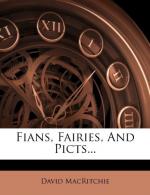[Footnote 37: Leabhar na Feinne, p. 34.
[SUBSEQUENT NOTE.—To be very accurate, one ought to say that, in the pedigree referred to, Fin’s grandfather (Trenmor) is stated to have married a Finland woman.]]
[Footnote 38: Mr. W.G. Black’s Heligoland, 1888, chap. iv.]
[Footnote 39: With this Fin of Frisian tradition may be compared Fin, a North-Frisian chief of the fifth century, mentioned in Beowulf and The Gleeman’s Tale, and whose death is recorded in The Fight at Finnsburk.
[SUBSEQUENT NOTE.—A suitable companion to the dwarf Fin of Frisian tradition is mentioned in Harald Hardradi’s Saga:—“Tuta, a Frisian, was with King Harald; he was sent to him for show, for he was short and stout, in every respect shaped like a dwarf.”—Quoted by Mr. Du Chaillu at p. 357 of vol. ii. of “The Viking Age."]]
[Footnote 40: In this connection it is worth noting that Sir Walter Scott, in referring to the aboriginal or servile clans in 1745, whom he describes as “half naked, stinted in growth, and miserable in aspect,” includes among them the McCouls, Fin’s alleged descendants, who “were a sort of Gibeonites, or hereditary servants to the Stewarts of Appin.” (Waverley, ch. xliv.)]
[Footnote 41: For example, the late Rev. J.G. Campbell, Tiree, says of “the Great Tuairisgeul” that he was “a giant of the kind called Samhanaich—that is, one who lived in a cave by the sea-shore, the strongest and coarsest of any” (Scottish Celtic Review, p. 62). That this term was one of contempt, given by Gaelic-speaking people to those “giants” (and apparently based upon their malodorous characteristics), will be seen from Mr. Campbell’s further observation (op. cit. pp. 140-141):—“It is a common expression to say of any strong offensive smell, mharbhadh e na Samhanaich, it would kill the giants who dwell in caves by the sea. Samk is a strong oppressive smell.” McAlpine defines Samk as a “bad smell arising from a sick person, or a dirty hot place”; and he further gives the definition “a savage” (quoting Mackenzie). The word Samhanach itself is defined by McAlpine as “a savage,” and he cites the Islay saying:—“chuireadh tu cagal air na samhanaich,” “you would frighten the very savages.” From these definitions it will be seen that a word translated “giant” by one is rendered “savage” by another (though neither of these terms expresses the literal meaning). Mr. J.G. Campbell also practically regards it as signifying “cave-dweller,” or perhaps a certain special caste of cave-dwellers. With this may be compared McAlpine’s “uamh, n.f., a cave, den; n.m., a chief of savages, terrible fellow ... ’cha’n’eil ann ach uamh dhuine,’ ‘he is only a savage of a fellow.’” Islay has also another word to denote a Hebridean savage. This is ciuthach, “pr. kewach, described in the Long Island




